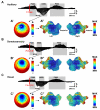Temporal dynamics of cortical sources underlying spontaneous and peripherally evoked slow waves
- PMID: 21854964
- PMCID: PMC3160723
- DOI: 10.1016/B978-0-444-53839-0.00013-2
Temporal dynamics of cortical sources underlying spontaneous and peripherally evoked slow waves
Abstract
Slow waves are the most prominent electroencephalographic feature of non-rapid eye movement (NREM) sleep. During NREM sleep, cortical neurons oscillate approximately once every second between a depolarized upstate, when cortical neurons are actively firing, and a hyperpolarized downstate, when cortical neurons are virtually silent (Destexhe et al., 1999; Steriade et al., 1993a, 2001). Intracellular recordings indicate that the origins of the slow oscillation are cortical and that corticocortical connections are necessary for their synchronization (Amzica and Steriade, 1995; Steriade et al., 1993b; Timofeev and Steriade, 1996; Timofeev et al., 2000). The currents produced by the near-synchronous slow oscillation of large populations of neurons appear on the scalp as electroencephalogram (EEG) slow waves (Amzica and Steriade, 1997). Despite this cellular understanding, questions remain about the role of specific cortical structures in individual slow waves. Early EEG studies of slow waves in humans were limited by the small number of derivations employed and by the difficulty of relating scalp potentials to underlying brain activity (Brazier, 1949; Roth et al., 1956). Functional neuroimaging methods offer exceptional spatial resolution, but lack the temporal resolution to track individual slow waves (Dang-Vu et al., 2008; Maquet, 2000). Intracranial recordings in patient populations are limited by the availability of medically necessary electrode placements and can be confounded by pathology and medications (Cash et al., 2009; Nir et al., 2011; Wenneberg 2010). Source modeling of high-density EEG recordings offers a unique opportunity for neuroimaging sleep slow waves. So far, the results have challenged several of the influential topographic observations about slow waves that had persisted since the original EEG recordings of sleep. These recent analyses revealed that individual slow waves are idiosyncratic cortical events and that the negative peak of the EEG slow wave often involves cortical structures not necessarily apparent from the scalp, like the inferior frontal gyrus, anterior cingulate, posterior cingulate, and precuneus (Murphy et al., 2009). In addition, not only do slow waves travel (Massimini et al., 2004), but they often do so preferentially through the areas comprising the major connectional backbone of the human cortex (Hagmann et al., 2008). In this chapter, we will review the cellular, intracranial recording, and neuroimaging results concerning EEG slow waves. We will also confront a long held belief about peripherally evoked slow waves, also known as K-complexes, namely that they are modality independent and do not involve cortical sensory pathways. The analysis included here is the first to directly compare K-complexes evoked with three different stimulation modalities within the same subject on the same night using high-density EEG.
Copyright © 2011 Elsevier B.V. All rights reserved.
Figures



Comment in
-
Slow brain oscillations of sleep, resting state, and vigilance.Prog Brain Res. 2011;193:3-15. doi: 10.1016/B978-0-444-53839-0.00001-6. Prog Brain Res. 2011. PMID: 21854952
Similar articles
-
Source modeling sleep slow waves.Proc Natl Acad Sci U S A. 2009 Feb 3;106(5):1608-13. doi: 10.1073/pnas.0807933106. Epub 2009 Jan 22. Proc Natl Acad Sci U S A. 2009. PMID: 19164756 Free PMC article.
-
Cellular basis of EEG slow rhythms: a study of dynamic corticothalamic relationships.J Neurosci. 1995 Jan;15(1 Pt 2):604-22. doi: 10.1523/JNEUROSCI.15-01-00604.1995. J Neurosci. 1995. PMID: 7823167 Free PMC article.
-
Sleep homeostasis and cortical synchronization: III. A high-density EEG study of sleep slow waves in humans.Sleep. 2007 Dec;30(12):1643-57. doi: 10.1093/sleep/30.12.1643. Sleep. 2007. PMID: 18246974 Free PMC article.
-
In Vivo Observations of Rapid Scattered Light Changes Associated with Neurophysiological Activity.In: Frostig RD, editor. In Vivo Optical Imaging of Brain Function. 2nd edition. Boca Raton (FL): CRC Press/Taylor & Francis; 2009. Chapter 5. In: Frostig RD, editor. In Vivo Optical Imaging of Brain Function. 2nd edition. Boca Raton (FL): CRC Press/Taylor & Francis; 2009. Chapter 5. PMID: 26844322 Free Books & Documents. Review.
-
Neuronal activities underlying the electroencephalogram and evoked potentials of sleeping and waking: implications for information processing.Neurosci Biobehav Rev. 1995 Fall;19(3):447-63. doi: 10.1016/0149-7634(95)00010-c. Neurosci Biobehav Rev. 1995. PMID: 7566746 Review.
Cited by
-
Lateralized tactile stimulation during NREM sleep globally increases both slow and fast frequency activities.Psychophysiology. 2023 Mar;60(3):e14191. doi: 10.1111/psyp.14191. Epub 2022 Sep 25. Psychophysiology. 2023. PMID: 36153813 Free PMC article.
-
Local Gamma Activity During Non-REM Sleep in the Context of Sensory Evoked K-Complexes.Front Neurosci. 2019 Oct 15;13:1094. doi: 10.3389/fnins.2019.01094. eCollection 2019. Front Neurosci. 2019. PMID: 31680829 Free PMC article.
-
Neural signatures of heterogeneity in risk-taking and strategic consistency.Eur J Neurosci. 2021 Nov;54(9):7214-7230. doi: 10.1111/ejn.15476. Epub 2021 Oct 12. Eur J Neurosci. 2021. PMID: 34561929 Free PMC article.
-
Enhanced Memory Consolidation Via Automatic Sound Stimulation During Non-REM Sleep.Sleep. 2017 Mar 1;40(3):zsx003. doi: 10.1093/sleep/zsx003. Sleep. 2017. PMID: 28364428 Free PMC article.
-
Sleep in patients with schizophrenia.Curr Sleep Med Rep. 2015 Jun 1;1(2):150-156. doi: 10.1007/s40675-015-0010-3. Epub 2015 Apr 11. Curr Sleep Med Rep. 2015. PMID: 26430610 Free PMC article.
References
-
- Amzica F, Steriade M. The K-complex: its slow (<1-Hz) rhythmicity and relation to delta waves. Neurology. 1997;49:952–959. - PubMed
-
- Amzica F, Steriade M. Cellular substrates and laminar profile of sleep K-complex. Neuroscience. 1998a;82:671–686. - PubMed
-
- Amzica F, Steriade M. Electrophysiological correlates of sleep delta waves. Electroencephalogr Clin Neurophysiol. 1998b;107:69–83. - PubMed
-
- Bastien CH, Crowley KE, Colrain IM. Evoked potential components unique to non-REM sleep: relationship to evoked K-complexes and vertex sharp waves. Int J Psychophysiol. 2002;46:257–274. - PubMed
Publication types
MeSH terms
Grants and funding
LinkOut - more resources
Full Text Sources
Other Literature Sources
Miscellaneous

